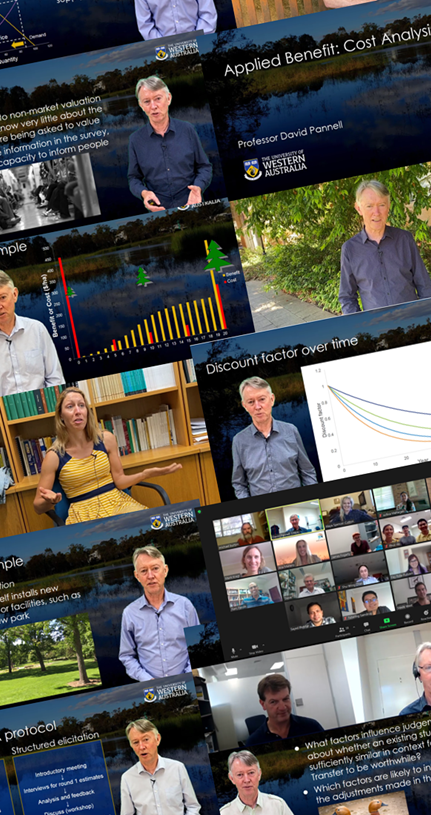382. BCA challenges: Who benefits? Who pays?
Here is the fifth video extract from my workshop called “Benefit-Cost Analysis: Traps, Challenges and Best Practice” presented on 7 February 2022, as part of the Australasian Agricultural and Resource Economics Society Annual Conference. It is about how to address the distribution of benefits and costs amongst stakeholders.
In this extract from the workshop, I talk about the two main approaches that have been proposed for representing the distribution of benefits and costs amongst stakeholders in a BCA. One is to apply weights to the benefits and costs depending on which group in society they accrue to. This is rarely done in practice. The other is to provide tables and graphs that show which stakeholders or groups receive how much of each type of benefit and pay how much of the costs. This is often helpful to decision makers and should be considered part of a best-practice approach.
Like all of the presentations in this series, it draws on my 12-week online micro-credential course on Applied BCA. This video is about 7 minutes long.
Brief introductory course on BCA
If you are new to BCA, here is a very introductory course, in 10 videos totalling 1 hour 14 minutes.
Comprehensive set of courses on Applied BCA
 I invite you to consider enrolling in my three 4-week online courses on Applied Benefit: Cost Analysis, covering The Essentials, Measuring Benefits and Practical Issues. Build your BCA expertise and gain the practical skills you need to undertake a complex Benefit: Cost Analysis. Online: high-quality video lectures and interviews, live workshops. No existing economics background required.
I invite you to consider enrolling in my three 4-week online courses on Applied Benefit: Cost Analysis, covering The Essentials, Measuring Benefits and Practical Issues. Build your BCA expertise and gain the practical skills you need to undertake a complex Benefit: Cost Analysis. Online: high-quality video lectures and interviews, live workshops. No existing economics background required.
Discounts are available for bulk enrolments and for enrolments from selected countries. Bursaries (with a discount of 90%) are also available for enrolments from selected countries.
For information on content, pricing, and how to apply for discounts or a bursary download this flier:
Applied BCA Flier v8 . For details of the content of each course, see PD385.
The course runs starting in late February and late July each year. To enrol, click here or on the image at left, and go to the Business and Commerce section.
“A fantastic program and course. It is by far the best course I have been involved in. I learned so much and there is still lots to learn which you have shared with links so I can return to refresh/learn as needed.”
“Essential for new BCA users.”
“Taught in an engaging way with many real-world examples.”
Hi David. There Would be a multitude of challenges to get meaningful social ‘weights’ for different segments of the community pertinent to a multitude of issues. Alternatively, leaving a Minister(s) to consider a table of policy incidence across different groups and thinking they will adjust policy responses in line with social trade offs is optimistic in the extreme. Look at decision making for new dams and the willingness of politicians to impose huge costs on the many for small benefits for the few. Indeed I have had ministers say to me that they do not want economists to provide a full accounting of c&b as it leaves them nowhere to go!
But we can drive better accountability and decision making if we provided estimates of the community’s willingness to pay for different distributional outcomes with different options to deliver the policy goal. This can readily be done through non-market valuation techniques (specifically stated preference surveys).
This approach would allow an objective and empirical estimate of net option benefits inclusive of distributional benefits and costs.
I have had a senior person in a Government department in Canberra say something similar – that they would prefer to have less information on a particular topic, clearly to allow them to make a politically preferred decision.
Eliciting the community’s preferences for different distributional outcomes is an interesting idea. I doubt that it would have much influence on a politician who was determined to make a particular decision. But a decision maker who was genuinely trying to make the best decision might find it helpful. On the other hand, such a decision maker would probably find a distributional table helpful too, I reckon.
In my view, the main reason to provide such a table is the one raised by Rob: identifying situations where there is a notable inconsistency in the incidence of benefits and costs and using that information to revise or renegotiate funding arrangements.
David – nice explanation in the video. It seems to me that a very practical reason to develop a matrix such as you show, is to help assess whether a mismatch between shares of costs and shares of benefits might lead to underinvestment by one or more stakeholder group(s), at least where investment is at all discretionary. This is certainly the case for investment in data (phenotypes) for genetic improvement in livestock – and reflects fragmented value chains and differences in pricing power between sectors. The typical outcome (it seems to me) is to leave a “burden” which may be picked up by collective industry and/or government funds – which sort of continues the problem in another form.